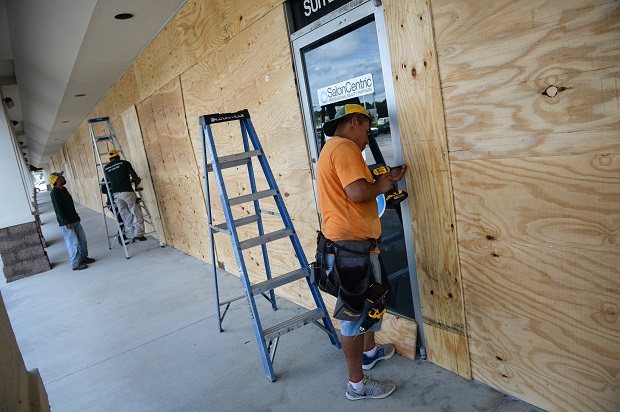 Workers secure plywood to businessexteriors ahead of Hurricane Florence in Wilmington, NorthCarolina. Besides millions of residents affected by winds andflooding, the markets are also anticipating a hit. (Photo: CharlesMostoller/Bloomberg)
Workers secure plywood to businessexteriors ahead of Hurricane Florence in Wilmington, NorthCarolina. Besides millions of residents affected by winds andflooding, the markets are also anticipating a hit. (Photo: CharlesMostoller/Bloomberg)
(Bloomberg) –The punch packed by Hurricane Florence is alreadyrattling markets from stocks to bonds.
|The massive storm — which is forcing more than 1 million peopleto flee and could wreak as much as $27 billion in damages as itcuts a path through the states of Georgia and the Carolinas — hasstruck insurance companies' shares and funds holding catastrophebonds as investors try to get ahead of the potential disaster.
|“Investor focus appears to be turning more and more to hurricaneFlorence and the damage and disruption it might create,” UniCreditBank analyst Erik Nielsen, the firm's global chief economist, wrotein a note.
|Here are some of the markets that are most vulnerable to theimpending storm:
|Stocks
Insurance companies could be on the hook as the storm may cause$15 billion to $20 billion in covered losses from wind and coastalstorm surge. Ahead of these possible claims, the sub-index ofinsurance firms in the S&P 500 has slid for five straightdays.
|Companies with the biggest exposure to the Southeast U.S.include Allstate Corp., Travelers Companies Inc., BerkshireHathaway Inc., The Progressive Corp., CNA Financial Corp. andAmerican International Group Inc., according to Wells FargoBank.
|Another sector that could take a beating are electric andnatural gas companies that serve the states in the potential pathof destruction. Duke Energy Corp. fell for a fourth day in a rowWednesday, the longest stretch in three months, while SCANA Corp.touched the lowest since June. Broadly, energy producers got aboost as the hurricane threatened to stretch crude supplies.
|Banks with large operations in the region facing Florence'strajectory include TowneBank, Carolina Financial Corp., UnionBankshares Crop., United Community Banks Inc., First Bancorp,Synovus Financial Corp. and BB&T Corp., according to RaymondJames. Financial firms paced declines on the stock benchmarkWednesday.
|Retail companies may also be affected as the storm forceslocations in harm's way to shutter. More than 10 percent of DollarGeneral and Dollar Tree's stores are in states in the path of thestorm. But purchases to prepare for the storm “could be partialoffsets,” according to Bloomberg Intelligence. As for departmentstores, Dillard's is the most-exposed with 9 percent of its storesin target states.
|Certain restaurants with locations in the region, includingBojangles Inc. and Carrols Restaurant, may also take a hit fromFlorence. With nearly 60 percent of its store locations in theCarolinas, Bojangles shares have fallen five straight days. Therestaurant operator fell 5.5 percent Wednesday, the most sinceMarch.
|Other industries that could be moved by Hurricane Florenceinclude cement and building materials stocks, auto parts suppliersas well as airlines and hotels due to potential cancellations.
|On the flip side, home-improvement retailers are seeing astorm-related boost. Home Depot Inc. and Lowe's Cos. both reachedall-time highs this week. Generac Holdings Inc., which makesgenerators, touched the highest since 2014 after rising more than 8percent over the previous four days before giving back some of thegain on Wednesday.
|Catastrophe bonds
Catastrophe bonds are perhaps the most direct bet on thepotential disaster: Insurers issue them to transfer risk of lossesrelated to events like hurricanes to investors.
|The Swiss Re Cat Bond Index, a widely-cited gauge forcatastrophe bond performance, hasn't moved on the news as itupdates only on Fridays. The index suffered a decline of 16 percentlast year during hurricane season that took about nine months torecoup. However, the benchmark hasn't had a negative year in datagoing back 15 years.
|But some mutual funds that invest in reinsurance products likecatastrophe bonds are already feeling the impact of the storm. The$5.8 billion Stone Ridge Reinsurance Risk Premium Interval Fundfell 5 percent Monday, its biggest one-day decline since lastSeptember when Hurricane Irma approached Florida. The fund, whichrecovered more than half its losses on Tuesday, provides regularpayments to investors but can lose money if storm damage costs aretoo high.
|Mortgage-backed securities
The collateral for more than $20 billion worth of commercialloans bundled into securities is located in North Carolina, SouthCarolina and Virginia, according to Morgan Stanley. Some $8.3billion worth of property sits within 25 miles of the coastline.The last time a hurricane of this magnitude struck South Carolina,it caused $4.2 billion of insured losses, the bank said.
|Consumer and residential mortgages are likely to be impacted bythe storm and many homes don't have flood insurance in thepotentially affected areas, Raymond James analyst David Longwrote.
|Agriculture
North Carolina is the top U.S. producer of tobacco crops. Thehurricane threatens to cause plants to rot, causing losses as highas $300 million, according to Matthew Vann, a tobacco specialist atthe North Carolina State University in Raleigh.
|Copyright 2018 Bloomberg. All rightsreserved. This material may not be published, broadcast, rewritten,or redistributed.
Complete your profile to continue reading and get FREE access to BenefitsPRO, part of your ALM digital membership.
Your access to unlimited BenefitsPRO content isn’t changing.
Once you are an ALM digital member, you’ll receive:
- Critical BenefitsPRO information including cutting edge post-reform success strategies, access to educational webcasts and videos, resources from industry leaders, and informative Newsletters.
- Exclusive discounts on ALM, BenefitsPRO magazine and BenefitsPRO.com events
- Access to other award-winning ALM websites including ThinkAdvisor.com and Law.com
Already have an account? Sign In
© 2024 ALM Global, LLC, All Rights Reserved. Request academic re-use from www.copyright.com. All other uses, submit a request to [email protected]. For more information visit Asset & Logo Licensing.








